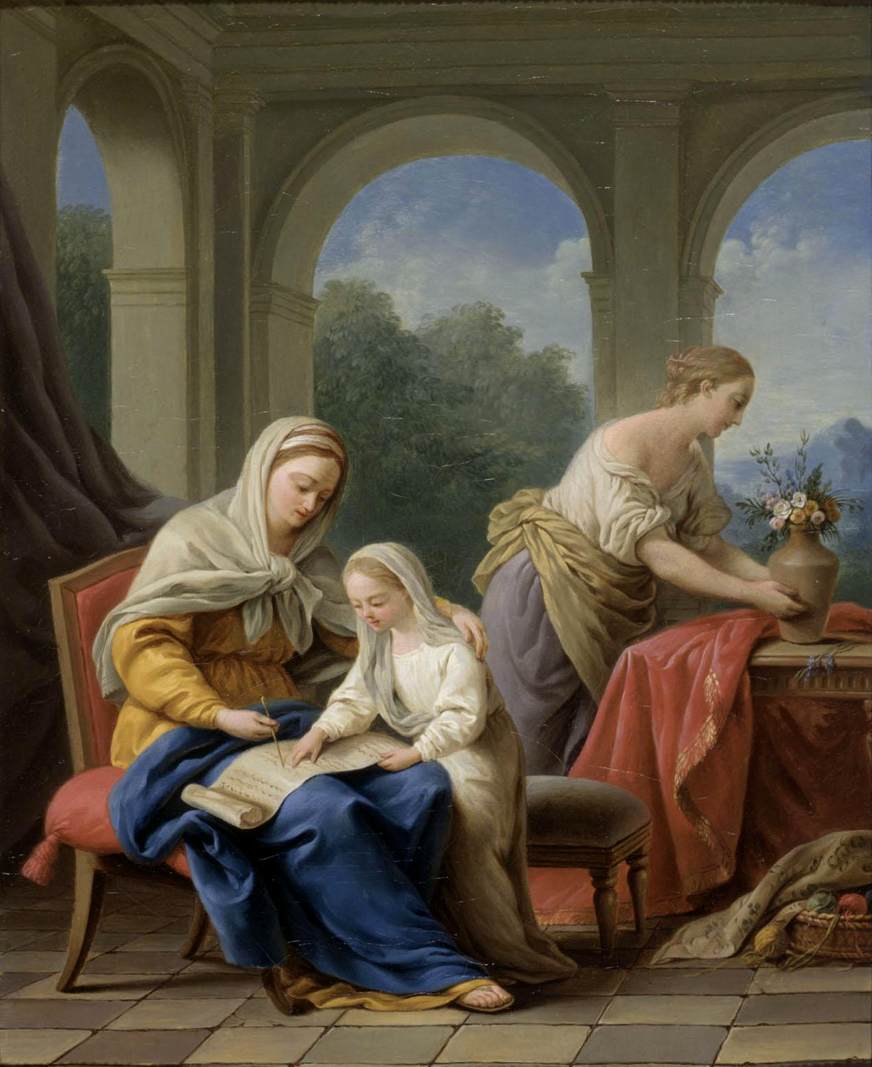French painter. He was a pupil of Carle Van Loo and won the Prix de Rome in 1749. He stayed for only one year at the Académie de France in Rome (1754). On his return to Paris in 1755 he was received (reçu) as a member by the Académie Royale on presentation of the Rape of Dejanira (Paris, Louvre), a work inspired by Guido Reni's painting of the same subject in the French royal collection (now Paris, Louvre). There followed a career filled with success and honours: from 1760 to 1762 he was Director of the St Petersburg Academy. In 1762 he was appointed a professor at the Académie Royale in Paris. Later, from 1781 to 1785, he was Director of the Académie de France in Rome, and in the latter year he became Recteur of the Académie Royale. From 1804 he was appointed a curator of the new national museums.
Lagrenée's prolific output is a measure of his numerous patrons, prominent among whom were the ecclesiastical authorities. Of his religious paintings, one of the most ambitious is the Assumption of the Virgin (exh. Salon 1759; Douai, St Pierre). In the 1770s a commission for a work depicting an episode from the life of St Louis for the chapel of the Ecole Militaire, Paris, enabled him to attempt the increasingly important genre of national history with the Audience of St Louis with Pope Innocent IV at Lyon (exh. Salon 1773; in situ). However, Lagrenée's most original contribution to the religious painting of his period consists of a series of devotional pictures on such engaging subjects as the Education of the Virgin, the Bath of the Infant Jesus, the Virgin Playing with the Infant Christ and a Sheep (all exh. Salon 1765; Karlsruhe, Staatliche Kunsthalle) and the Penitent Magdalene (exh. Salon 1765; private collection). In these pictures he deliberately rejected the Rococo aesthetic of the middle years of the 18th century and revived instead the classicising taste of the previous century, looking for inspiration to the art of Francesco Albani and to the tradition of French history painting from Eustache Le Sueur to Louis de Boullogne.
Lagrenée also received many royal commissions from the Bâtiments du Roi. Among them was a pair of allegorical overdoors for the gallery of the château of Choisy, Val-de-Marne, Justice and Mercy and Goodness and Generosity (exh. Salon 1765; Fontainebleau, Château). The decorative programme of the gallery devised by Charles-Nicolas Cochin II celebrated the generous actions of the good emperors. Lagrenée also painted two circular canvases for the Chambre du Roi at the Château de Bellevue, near Meudon, Mars and Venus Surprised by Vulcan and Psyche Surprising the Sleeping Cupid (both exh. Salon 1769; Paris, Louvre). Together with Ceres and Triptolemus (1769; Versailles, Petit Trianon), these works reveal Lagrenée's desire to simplify his compositions and further refine his drawing. With Joseph-Marie Vien and Jean-Baptiste Greuze he was responsible for a genuine change in direction for the French school away from the Rococo style towards a more restrained, classicising idiom.
During the 1770s Lagrenée's art attained a high degree of formal perfection that won him a faithful and numerous clientele of private patrons in France and abroad. He excelled at medium-size and small paintings in which elegiac subjects were treated with rare felicity in cool colours, a smooth technique and a simple and refined execution, as in the Lacedaemonian Mother and Telemachus and Termosiris (both 1770; Stourhead, Wilts, NT). The Death of Cleopatra (1774; Paris, Louvre) shows this style brought to perfection. Lagrenée also liked to paint allegories, whether these were occasional commissions, as with the Poussinesque Allegory on the Death of the Dauphin (exh. Salon 1767; Fontainebleau, Château), or satires, such as the Love of the Arts Consoling Painting over the Ridiculous and Venomous Writings of her Enemies (exh. Salon 1781; Paris, Louvre).
Lagrenée had more skill than imagination and was not at ease with large-scale works: Diderot noted with regret that 'the larger his canvas, the more his talent diminishes', although on the whole he liked his work. The large paintings commissioned between 1777 and 1789 by the Comte d'Angiviller, Directeur-Général des Bâtiments du Roi for the Manufacture des Gobelins, such as the Two Widows of an Indian Officer (exh. Salon 1783; Dijon, Hôtel de Ville), were thus less innovative than his smaller pictures. In Popilius and Antiochus Epiphanes (exh. Salon 1779; Lille, Musée des Beaux-Arts), the figures arranged in a frieze against an architectural background help to express the high-minded theme; the Preparations for the Battle between Paris and Menelaus (exh. Salon 1781; Paris, Louvre) has a more theatrical inspiration, suitable to the epic subject; the Death of the Wife of Darius (exh. Salon 1785; Paris, Louvre) is a modern version of Charles Le Brun's Tent of Darius (Paris, Louvre), while the Fidelity of One of Darius's Satraps (exh. Salon 1787; Aurillac, Musée Hippolyte de Parieu) is striking for its Neo-classical concern for archaeological accuracy.
Throughout his career Lagrenée kept a livre de raison recording his works. Now held at the Bibliothèque Doucet, University of Paris, and published by E. de Goncourt in 1877, it forms a valuable resource for the study of his work, listing 457 items.
//
![]()









